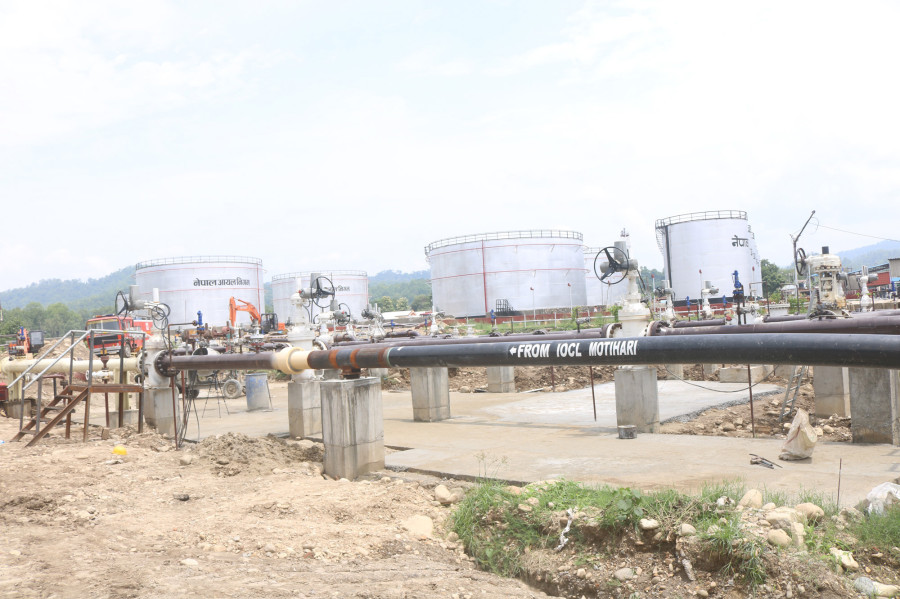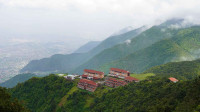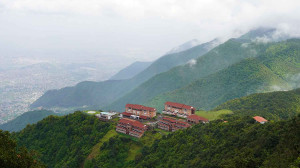Money
Oil pipeline will be a boon for the economy, but could make Nepal further dependent on India, experts say
Nepali officials say the cross-border pipeline will go into commercial operation by August 15
Sangam Prasain
The Nepal-India cross border petroleum pipeline project is coming closer to reality after more than 20 years in the planning, and officials expect gasoline [petrol, diesel and kerosene] to start flowing through as early as next month following successful tests sending oil and water through the pipeline this week.
Energy experts say the 69.2-km project makes perfect sense from bilateral trade and economic advantage, but they worry that it could result in making Nepal even more dependent on India. Of the Amlekhgunj-Motihari pipeline’s total length, 36.2 km lies within Nepali territory. The fuel pumping facilities will be located in Motihari, India.
“This pipeline will make us further dependent on India because we have to deal with a single company,” said Amrit Nakarmi, professor at the Center for Energy Studies at the Institute of Engineering, “and that is not good at all.”
As a landlocked nation, Nepal imports all of its petroleum supplies from India, through which roughly 300 fuel trucks enter the country on a normal day.
Nakarmi, who is also the former executive director of Nepal Oil Corporation, warned that a small disturbance in supply can create havoc and hit the economy.
“We have had to deal with several examples of energy security in the past, and the lesson is India being an oil monopoly for Nepal is not good,” he said.
But officials say the pipeline will be a boon for the country, not only in reducing transportation costs and eliminating the hassles of hiring tanker trucks but also running operation during strikes that often hamper petroleum imports through the Indian border.
“The pipeline will save around Rs2 billion in transportation cost annually and another Rs1 billion in leakage costs,” said Pradip Yadav, chief of the Amlekhgunj Depot. “Most importantly, the pipeline will end fuel adulteration.”
Fuel adulteration is a major problem in Nepal and has been growing at an alarming rate. The Nepal Bureau of Standards and Metrology reports showed that the diesel sold in the valley was heavily adulterated. A number of reports have shown that most of the fuel adulteration cases occur on the Amlekhgunj-Raxaul route.
Although the exact date for the inauguration of the project has not been fixed, Nepali officials say the pipeline will go into commercial operation by August 15. In the initial stage, the corporation plans to import diesel through the pipeline. It will not be used to import liquefied petroleum gas—popularly known as cooking gas. The pipeline has a capacity to pump fuel at the rate of 291 kilolitres per hour.
According to Yadav, the pipeline will pump petrol and kerosene only after a year following the construction of vertical tanks to store them in Amlekhgunj. Similarly, for two years period, the Indian Oil Corporation will be pumping fuel to Nepal through its depot in Patna as it has been constructing a new oil terminal at Motihari in Bihar to supply fuel to Nepal through the pipeline.
Construction work on the pipeline started on March 9 last year, more than 20 years after the first discussions were held between Nepal and India on implementing the project. Under the first phase of the project, a pipeline will be laid from Raxaul to Amlekhgunj. In the second phase, it will be extended to Kathmandu.
Indian Oil Corporation had proposed constructing a cross-border pipeline in 1995 and signed a memorandum of understanding with Nepal Oil Corporation at the junior executive level a year later. In 2004, the two sides upgraded the agreement to the chief executive level. However, due to a number of legal hurdles, the project failed to take off.
The plan was revived after Indian Prime Minister Narendra Modi’s visit to Nepal on August 3, 2014, and pledged to build the pipeline.
Indian Oil Corporation provided most of the funds to build the pipeline, which is estimated to cost Rs4.4 billion. Nepal Oil Corporation’s expenses included land compensation payments and the cost of building infrastructure and upgrading its depot in Amlekhgunj.
According to the central bank, Nepal’s oil imports soared 28.4 percent to a staggering Rs194.43 billion in the first 11 months of the last fiscal year, which ended this week.
What do you think?
Dear reader, we’d like to hear from you. We regularly publish letters to the editor on contemporary issues or direct responses to something the Post has recently published. Please send your letters to [email protected] with "Letter to the Editor" in the subject line. Please include your name, location, and a contact address so one of our editors can reach out to you.




 7.98°C Kathmandu
7.98°C Kathmandu















